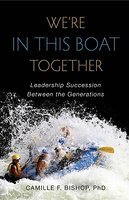How to work with different generations

 We’re In A Boat Together is Camille Bishop’s a fictionalized account about four individuals who work together in a company that is experiencing a change in leadership. What’s interesting is Bishop’s analysis concerning the different generations in the workplace.*
We’re In A Boat Together is Camille Bishop’s a fictionalized account about four individuals who work together in a company that is experiencing a change in leadership. What’s interesting is Bishop’s analysis concerning the different generations in the workplace.*
There are four generations in the workplace today, the Silent, Boomer, Gen Xer, and Millennial generations. The story follows four individuals from four generations who embark on a leadership building rafting trip, and illustrates how each group sees and interacts with the world.
The generations represented in the work force are:
• The Silent Generation (1925 – 1942) grew up between two World Wars and are distinguished by morality, duty, self-denial, hard work, and integrity. Their work is their life and they are as loyal to their organization as they are to their families.
• Baby Boomers (1943-1960) – grew up in a period of unparalleled American achievement and progress but are actually broken into two categories. Early Boomers are high achievers who seize opportunity and expect the best rewards as a result. Late Boomers, affected the breakdown of the social status quo in the sixties, are strong, responsible and individualistic.
• Gen Xers (1961-1981) – grew up in the midst of technological advancements. The high freedom they were given from social changes like two career parents and broken homes resulted in loneliness and desire for community. This affected their relationship with leadership as they desire collaboration in the workplace and give respect to leadership only when earned.
• Millennials (1982-2002) – grew up with computers and internet as commonalities. They were sheltered by protective parents and now come to see the world as dangerous and unpredictable. They rely on technology to give them an edge on it. They demand instant gratification and high results from little work.
There are different best practices she recommends for working with individuals in each generation:
Best practices for the Silent Generation:
• Their leadership style was shaped by military service. Therefore, respect for authority is their highest priority.
• If they are leaders, be cautious and gentle in questioning their decisions.
• Demand clear vision on the future and decisiveness.
• They respect integrity, faithfulness, self-control and foresight.
Best practices for the Boomers:
• Late Boomers want to be included in decisions and be free to disagree.
• Late Boomers want relationship oriented leaders.
• Be transparent, caring, empowering, genuine, and hands off.
• Respect credibility.
Best practices for the Gen Xers:
• Be willing to collaborate.
• Foster a organizational community.
• They want leaders who care about them personally and are willing to compromise for their sake.
• May be uncomfortable about taking up leadership. Give them responsibility gradually and expect opposition to long term commitment.
• Respect caring concern, encouragement, love, humility, servanthood, teachability, and integrity.
Best practices for the Millennials:
• As with Gen Xers, they want leaders who care about them personally and are willing to compromise for their sake.
• Give continuous feedback.



Nice snapshots of the various generation. Obvious, one’s mileage will vary per individual, but a great overview.
Very insightful indeed! I am thankful for leaders like you Seth who work so well with multiple generations!!
Megan
Insightful and I think right on point. Thanks!
do you think the generational descriptions are accurate across color lines? or do you think they are more accurate of white culture? if yes, how would you say this affects the applications or best practice?
Interesting (and odd) question. I know this question is for the author so I am merely offering an opinion. In my observation the generations represented in the work force are all-inclusive and color blind. There are no separate work practices within a work/professional/team environment for separate races. The idea is cohesion, team effort, and cooperation–not division or special treatment based on race. Seems that would be racist/racism. I think these applications are fitting across the board.
not odd. for the last 100 years this country has been working through a color issue. and black person during the silent generation was under completely different circumstances than any white person (even if they were poor). self denial and hard work meant different things to them…
the early boomers of color were not rewarded for high achievement except in certain areas of the country.
not trying to make a statement on racism here but unless this author considered a systemic power structure that kept racism in place for a hundred years beyond the emancipation of slaves then these definitions only apply to people of privilege.
Thanks for expounding your point. That is a broad, sweeping generalization of victimization, and a viewpoint that I personally do not subscribe to although I understand your point. Thanks again, I learned something.
seth would love that people are debating on his blog…
some people get to subscribe. some people live it with no choice. that would be my final comment. enjoy your non subscription
🙂 what? what does that mean? Thanks! 🙂
I think that a really good point has been made here- but I would move it away from colour.
The way that these categories are divided are based on broad, collective experience of people of a similar age, at a similar time, in a similar place.
Instead of asking if these hold true across the colour lines I would ask if they hold true across different cultures that have been through different collective experiences.
This is insightful. I imagine there’s probably some overlap based on circumstantial environments as well. Single parents, military families and the like. Very interesting stuff to know though when in a work or leadership model. Thanks for sharing this!